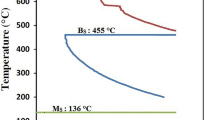Abstract
Does brittle fracture instability start from a single event such as a cracked carbide or sulfide or does it start from a series of discontinuous cleavage events, which coalesce together? In fact, either of these may occur depending on the test temperature (low or high), the amount of stored elastic energy at a crack tip (blunt or sharp), and the microstructure of brittle second phases (coarse or fine). The present study was to sort out which of these processes occurs in a coarse-grained high strength, low alloy (HSLA) steel tested at—80 °C (193 K). Statistical distributions of grains and fracture origins were identified in this 108 µm grain size steel. This was accomplished with compact tension specimens equipped with plezoceramic transducers to evaluate microcleavage onset. Termination of the test at various stress intensity levels, KI, followed by fatigue cracking at ΔK << K,I, allowed isolation of multiple cleavage origins. Both the amount of cleavage fracture and a preliminary estimate of fracture toughness could be interpreted in terms of process zone concepts. These rely on a local cleavage fracture stress controlled by microgeometry and a quasi-static equilibrium governed by the process zone size and strength. The conclusion for the steel in the present study is that a discontinuous process zone approach is most descriptive of the stochastic events leading up to brittle fracture.
Similar content being viewed by others
References
T. Lin, A. G. Evans, and R. O. Ritchie:Acta Metall., 1986, vol. 34, no. 11, pp. 2205–16.
J. Dvorak: inFracture 1969, P. L. Pratt, E. H. Andrews, R. L. Bell, N. E. Frost, R. W. Nichols, and E. Smith, eds., Chapman and Hall, London, 1969, pp. 338–49.
R. G. Hoagland, A. R. Rosenfield, and G. T. Hahn:Metall. Trans., 1972, vol. 3, pp. 123–36.
W. W. Gerberich and N. Moody: inFatigue Mechanisms, J. Fong, ed., ASTM, Philadelphia, PA, 1979, pp. 292–341.
W. W. Gerberich:Fracture and Interactions of Microstructure, Mechanism and Mechanics, J. M. Wells and J. D. Landes, eds., TMS-AIME, Warrendale, PA, 1985, pp. 49–74.
K. A. Esaklul, W. W. Gerberich, and J. P. Lucas: inInt. Conf. on Technology and Applications of HSLA Steel, ASM Metals Congress Paper 8306-020, ASM, Metals Park, OH, 1983.
ASTM Standard E399-81, Annual Book of ASTM Standards, Part 10, 1981.
W.W. Gerberich and E. Kurman:Scripta Metall., 1985, vol. 19, pp. 295–98.
C. S. Lee, T. Livne, and W. W. Gerberich:Scripta Metall., 1986, vol. 20, pp. 1137–40.
H. N.G. Wadley, C. B. Scruby, and J. H. Speake:Intern. Metals Revs., 1980, no. 2, pp. 41–64.
J. D. Desai and W. W. Gerberich:Engng. Fract. Mech., 1975, vol. 7, pp. 153–65.
W. W. Gerberich and K. Jatavallabhula: inNondestructive Evaluation: Microstructural Characterization and Reliability Strategies, O. Buck and S.M. Wolf, eds., TMS-AIME, Warrendale, PA, 1981, pp. 319–48.
M. Kaczorowski and W. W. Gerberich:Scripta Metall., 1986, vol. 20, pp. 1597–1600.
J. Huit and F. McClintock:9th Intern. Congress Appl. Mech., Brussels, 1956, vol. 8, pp. 51–58.
W. W. Gerberich and N. Moody: inFracture 1977, D. M. R. Taplin, ed., ICF4, Waterloo, ON, Canada, 1977, vol. 3, pp. 829–37.
W. W. Gerberich and A. G. Wright: inProc. 2nd Int. Conf. on Mate rials Degradation, Virginia Tech. Printing, Blacksburg, VA, 1981, pp. 183–206.
G. T. Hahn and A. R. Rosenfield:Trans. ASM, 1966, vol. 59, p. 909.
W.W. Gerberich and Y.T. Chen:Metall. Trans. A, 1975, vol. 6A, pp. 271–78.
R. O. Ritchie: Metal Science, Aug./Sept. 1977, pp. 368–81.
a.W. W. Gerberich: “Metallurgical Aspects of Crack-Tip Failure Processes,” ASTM Special Tech. Publ., 1986, in press.
b.W. W. Gerberich: “Metallurgical Aspects of Crack-Tip Failure Processes,” ASTM Special Tech. Publ. 945, R.P. Reed and D. T. Read, eds., Philadelphia, PA, 1987, pp. 5–18.
D.S. Dugdale:J. Mech. Phys. Solids, 1960, vol. 8, pp. 100–08.
G.I. Barenblatt:in Adv. in Applied Mech., H.L. Dryden and T. von Karman, eds., Academic Press, New York, NY, 1962, vol. 7.
Author information
Authors and Affiliations
Additional information
This paper is based on a presentation made at the symposium “Stochastic Aspects of Fracture” held at the 1986 annual AIME meeting in New Orleans, LA, on March 2-6, 1986, under the auspices of the ASM/MSD Flow and Fracture Committee.
Rights and permissions
About this article
Cite this article
Gerberich, W.W., Chen, S.H., Lee, C.S. et al. Brittle fracture: Weakest link or process zone control?. Metall Trans A 18, 1861–1875 (1987). https://doi.org/10.1007/BF02647016
Issue Date:
DOI: https://doi.org/10.1007/BF02647016




